2013 PEUGEOT 5008 tow
[x] Cancel search: towPage 5 of 364

CONTENTS
ALPHABETICAL
INDEX349-353
DRIVING 141-171
CHECKS 172-180
PRACTICAL
INFORMATION 181-216
TECHNICAL DATA 217-226
AUDIO EQUIPMENTand TELEMATICS 227-348
Electric parking brake...................141Hill start assist..............................146Head-up display...........................149Distance alert ...............................151Speed limiter................................r153Cruise control...............................155Manual gearbox ............................157Gear shift indicator.......................r1576-speed electronic gear control gearbox......................................158Automatic gearbox.......................162Stop & Start ..................................165Parking sensors ............................168Parking space sensors.................170
Bonnet ..........................................173Running out of fuel (Diesel)..........174Petrol engines ..............................175Diesel engines..............................176Checking levels............................177Checks..........................................179
Temporary puncture repair kit......181Changing a wheel.........................190Changing a bulb...........................196Changing a fuse ...........................20112 V battery ..................................208Energy economy mode.................211Changing a wiper blade................211Towing the vehicle ........................212Towing a trailer.............................r213Fitting roof bars............................214Very cold climate screen..............215Accessories..................................216
Petrol engines..............................217Petrol weights...............................218Diesel engines ..............................219Diesel weights ..............................220Dimensions ...................................224Identification markings..................225
Emergency or assistance.............227Peugeot Connect Media Navigation (NG4 3D)....................................231Peugeot Connect Navigation(RT6) ..........................................275Peugeot Connect Sound (RD5)...329
VISUAL
SEARCH354-360
Page 23 of 364
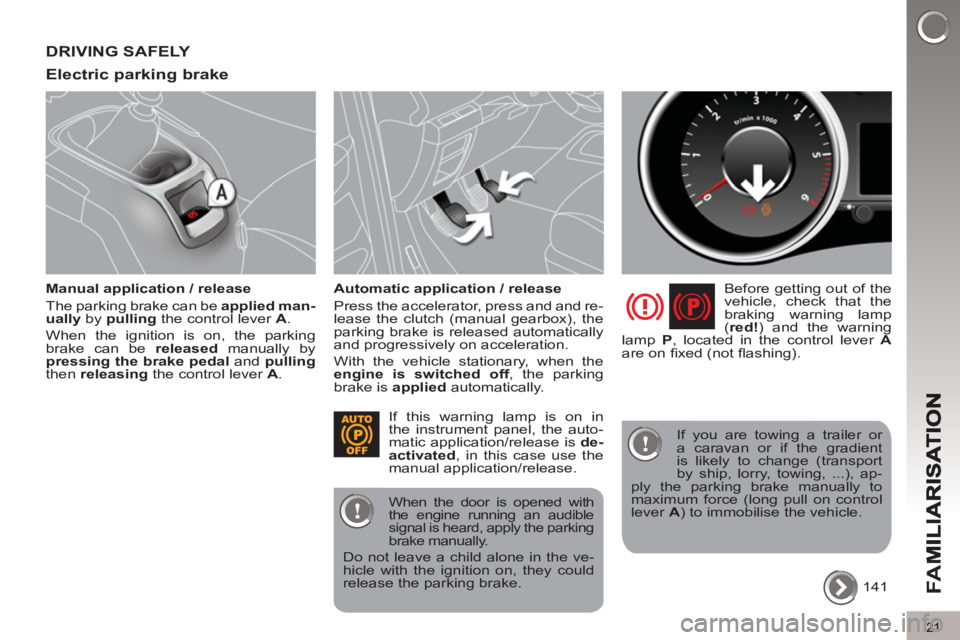
FA
M
21
DRIVING SAFELY
Electric parkin
g brake
Manual application / release
The parking brake can be applied man-
ually
by pulling
the control lever A
.
When the ignition is on, the parking
brake can be released
manually by
pressing the brake pedal
and pulling
then releasing
the control lever A
.
Automatic application / release
Press the accelerator, press and and re-
lease the clutch (manual gearbox), the
parking brake is released automatically
and progressively on acceleration.
With the vehicle stationary, when the
engine is switched off
, the parking
brake is applied
automatically.
Before getting out of the
vehicle, check that the
braking warning lamp
( red!
) and the warning
lamp P
, located in the control lever A
are on fi xed (not fl ashing).
141 If this warning lamp is on in
the instrument panel, the auto-
matic application/release is de-
activated
, in this case use the
manual application/release.
When the door is opened with
the engine running an audible
signal is heard, apply the parking
brake manually.
Do not leave a child alone in the ve-
hicle with the ignition on, they could
release the parking brake.
If you are towing a trailer or
a caravan or if the gradient
is likely to change (transport
by ship, lorry, towing, ...), ap-
ply the parking brake manually to
maximum force (long pull on control
lever A
) to immobilise the vehicle.
Page 27 of 364
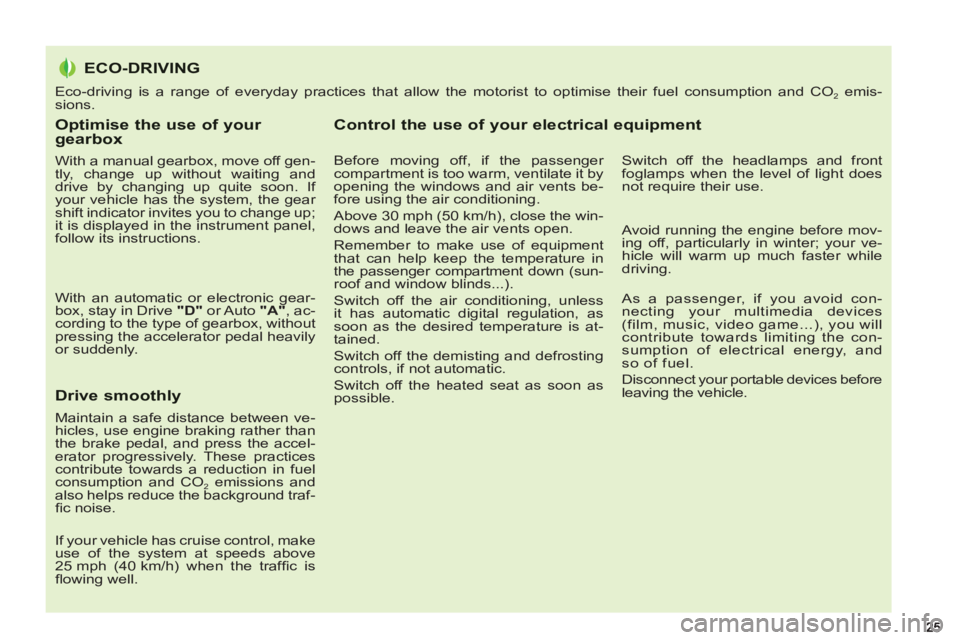
Optimise the use of your gearbox
With a manual gearbox, move off gen-
tly, change up without waiting and
drive by changing up quite soon. If
your vehicle has the system, the gear
shift indicator invites you to change up;
it is displayed in the instrument panel,
follow its instructions.
With an automatic or electronic gear-
box, stay in Drive "D"
or Auto "A"
, ac-
cording to the type of gearbox, without
pressing the accelerator pedal heavily
or suddenly.
Drive smoothly
Maintain a safe distance between ve-
hicles, use engine braking rather than
the brake pedal, and press the accel-
erator progressively. These practices
contribute towards a reduction in fuel
consumption and CO
2 emissions and
also helps reduce the background traf-
fi c noise.
If your vehicle has cruise control, make
use of the system at speeds above
25 mph (40 km/h) when the traffi c is
fl owing well.
Control the use of your electrical equipment
Before moving off, if the passenger
compartment is too warm, ventilate it by
opening the windows and air vents be-
fore using the air conditioning.
Above 30 mph (50 km/h), close the win-
dows and leave the air vents open.
Remember to make use of equipment
that can help keep the temperature in
the passenger compartment down (sun-roof and window blinds...).
Switch off the air conditioning, unless
it has automatic digital regulation, as
soon as the desired temperature is at-
tained.
Switch off the demisting and defrosting
controls, if not automatic.
Switch off the heated seat as soon as
possible.
Switch off the headlamps and front
foglamps when the level of light does
not require their use.
Avoid running the engine before mov-
ing off, particularly in winter; your ve-
hicle will warm up much faster while
driving.
As a passenger, if you avoid con-
necting your multimedia devices
(film, music, video game...), you will
contribute towards limiting the con-
sumption of electrical energy, and
so of fuel.
Disconnect your portable devices before
leaving the vehicle.
ECO-DRIVING
2525
Eco-driving is a range of everyday practices that allow the motorist to optimise their fuel consumption and CO2 emis-
sions.
Page 32 of 364
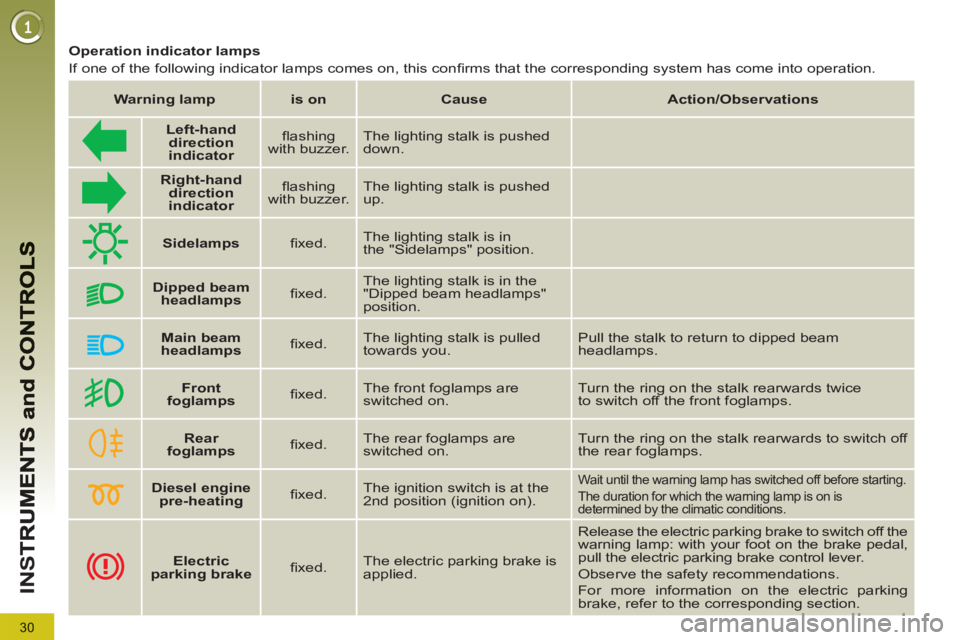
30
IN
S
Diesel engine
pre-heating
fi xed. The ignition switch is at the
2nd position (ignition on). Wait until the warning lamp has switched off before starting.
The duration for which the warning lamp is on is
determined by the climatic conditions.
Left-hand
direction
indicato
r
fl ashing
with buzzer. The lighting stalk is pushed
down.
Right-hand
direction
indicator
fl ashing
with buzzer. The lighting stalk is pushed
up.
Operation indicator lamps
If one of the following indicator lamps comes on, this confi rms that the corresponding system has come into operation.
Warning lamp
is on
Cause
Action/Observations
Sidelamps
fi xed. The lighting stalk is in
the "Sidelamps" position.
Dipped beam
headlamps
fi xed. The lighting stalk is in the
"Dipped beam headlamps"
position.
Main beam
headlamps
fi xed. The lighting stalk is pulled
towards you. Pull the stalk to return to dipped beam
headlamps.
Front
foglamps
fi xed. The front foglamps are
switched on. Turn the ring on the stalk rearwards twice
to switch off the front foglamps.
Rear
foglamps
fi xed.
The rear foglamps are
switched on. Turn the ring on the stalk rearwards to switch off
the rear foglamps.
Electric
parking brake
fi xed. The electric parking brake is
applied. Release the electric parking brake to switch off the
warning lamp: with your foot on the brake pedal,
pull the electric parking brake control lever.
Observe the safety recommendations.
For more information on the electric parking
brake, refer to the corresponding section.
Page 53 of 364
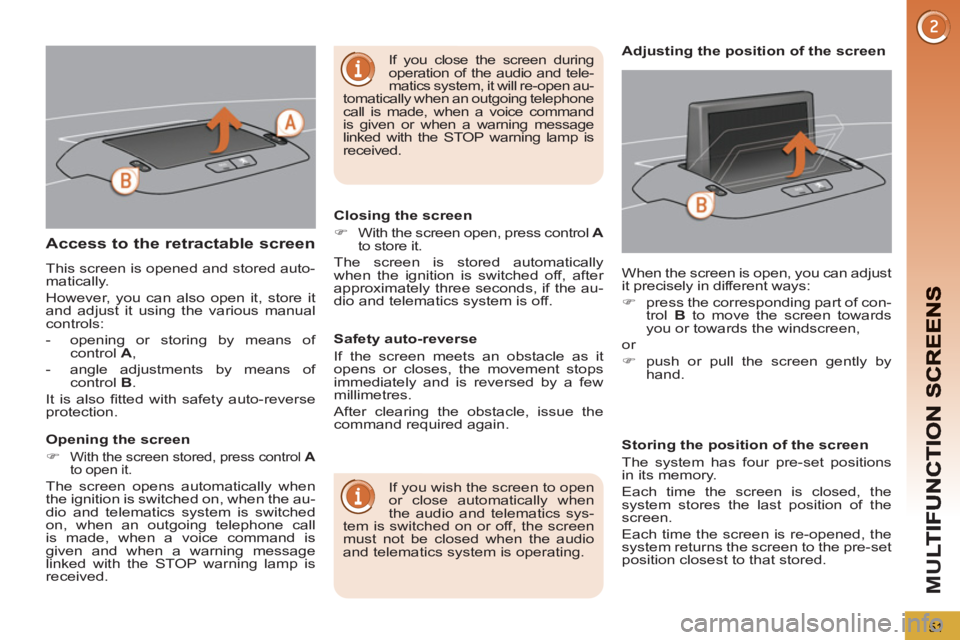
M
U
51
Access to the retractable screen
This screen is opened and stored auto-
matically.
However, you can also open it, store it
and adjust it using the various manual
controls:
- opening or storing by means of
control A
,
- angle adjustments by means of
control B
.
It is also fi tted with safety auto-reverse
protection.
Opening the screen
�)
With the screen stored, press control A
to open it.
The screen opens automatically when
the ignition is switched on, when the au-
dio and telematics system is switched
on, when an outgoing telephone call
is made, when a voice command is
given and when a warning message
linked with the STOP warning lamp is
received.
Closing the screen
�)
With the screen open, press control A
to store it.
The screen is stored automatically
when the ignition is switched off, after
approximately three seconds, if the au-
dio and telematics system is off.
If you wish the screen to open
or close automatically when
the audio and telematics sys-
tem is switched on or off, the screen
must not be closed when the audio
and telematics system is operating. When the screen is open, you can adjust
it precisely in different ways:
�)
press the corresponding part of con-
trol B
to move the screen towards
you or towards the windscreen,
or
�)
push or pull the screen gently by
hand.
Adjusting the position of the screen
Safety auto-reverse
If the screen meets an obstacle as it
opens or closes, the movement stops
immediately and is reversed by a few
millimetres.
After clearing the obstacle, issue the
command required again.
Storing the position of the screen
The system has four pre-set positions
in its memory.
Each time the screen is closed, the
system stores the last position of the
screen.
Each time the screen is re-opened, the
system returns the screen to the pre-set
position closest to that stored.
If you close the screen during
operation of the audio and tele-
matics system, it will re-open au-
tomatically when an outgoing telephone
call is made, when a voice command
is given or when a warning message
linked with the STOP warning lamp is
received.
Page 59 of 364

CO
57
The air conditioning system
does not contain chlorine and
does not present any danger
to the ozone layer.
Recommendations for ventilation and air conditioning
REAR VENTILATION
ADJUSTMENT
After pressing the "REAR" button, turn
the adjustment dial of the rear side
vents to decrease or increase the fl ow
of air.
Take care not to obstruct the side vents
and the air outlets on the fl oor.
To shut off the fl ow of air, close the vents
and set the dial to 0. In order for these systems to be fully effective, follow the operation and
maintenance guidelines below:
�)
If the interior temperature remains very high after the vehicle has been
parked in the sun for a considerable time, fi rst ventilate the passenger
compartment for a few minutes.
Place the air fl ow control at a suffi cient level to provide an adequate renewal
of air in the passenger compartment.
�)
To obtain an even air distribution, take care not to obstruct the exterior air
intake grilles located at the base of the windscreen, the nozzles, the vents
and the air outlets, as well as the air extractor located in the boot.
�)
Use in preference the intake of exterior air as prolonged use of the air
recirculation may cause misting of the windows and side windows.
�)
Do not cover the sunshine sensor, located on the dashboard; this is used for
regulation of the automatic air conditioning system.
�)
Operate the air conditioning system for 5 to 10 minutes, once or twice a
month to keep it in good working order.
�)
Ensure that the passenger compartment fi lter is in good condition and have
the fi lter elements replaced regularly (refer to the "Checks" section).
We recommend the use of a combined passenger compartment fi lter. Thanks
to its second special active fi lter, it contributes to the purifi cation of the air
breathed by the occupants and the cleanliness of the passenger compartment
(reduction of allergic symptoms, bad odours and greasy deposits).
�)
The air conditioning uses power from the engine while operating. This results
in an increase in the vehicle's fuel consumption.
When towing at or near maximum capacity or on steep slopes in high ambient
temperatures, switching off the air conditioning saves engine power and so
improves towing capacity.
Condensation created by the air conditioning results in a discharge of water
under the vehicle when stationary, which is perfectly normal.
�)
To ensure correct operation of the air conditioning system, you are also advised
to have it checked regularly.
�)
If the system does not produce cold air, do not use it and contact a PEUGEOT
dealer or a qualifi ed workshop.
Page 63 of 364
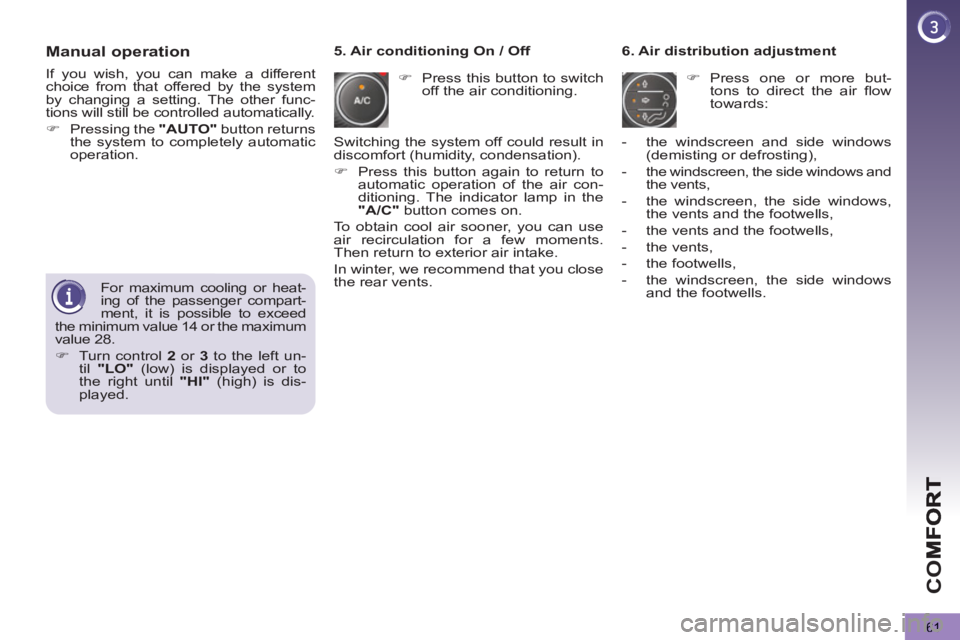
CO
61
Manual operation
�)
Press this button to switch
off the air conditioning.
6. Air distribution adjustment
�)
Press one or more but-
tons to direct the air fl ow
towards:
5. Air conditioning On / Off
- the windscreen and side windows
(demisting or defrosting),
- the windscreen, the side windows and
the vents,
- the windscreen, the side windows,
the vents and the footwells,
- the vents and the footwells,
- the vents,
- the footwells,
- the windscreen, the side windows
and the footwells.
For maximum cooling or heat-
ing of the passenger compart-
ment, it is possible to exceed
the minimum value 14 or the maximum
value 28.
�)
Turn control 2
or 3
to the left un-
til "LO"
(low) is displayed or to
the right until "HI"
(high) is dis-
played.
Switching the system off could result in
discomfort (humidity, condensation).
�)
Press this button again to return to
automatic operation of the air con-
ditioning. The indicator lamp in the
"A/C"
button comes on.
To obtain cool air sooner, you can use
air recirculation for a few moments.
Then return to exterior air intake.
In winter, we recommend that you close
the rear vents.
If you wish, you can make a different
choice from that offered by the system
by changing a setting. The other func-
tions will still be controlled automatically.
�)
Pressing the "AUTO"
button returns
the system to completely automatic
operation.
Page 64 of 364
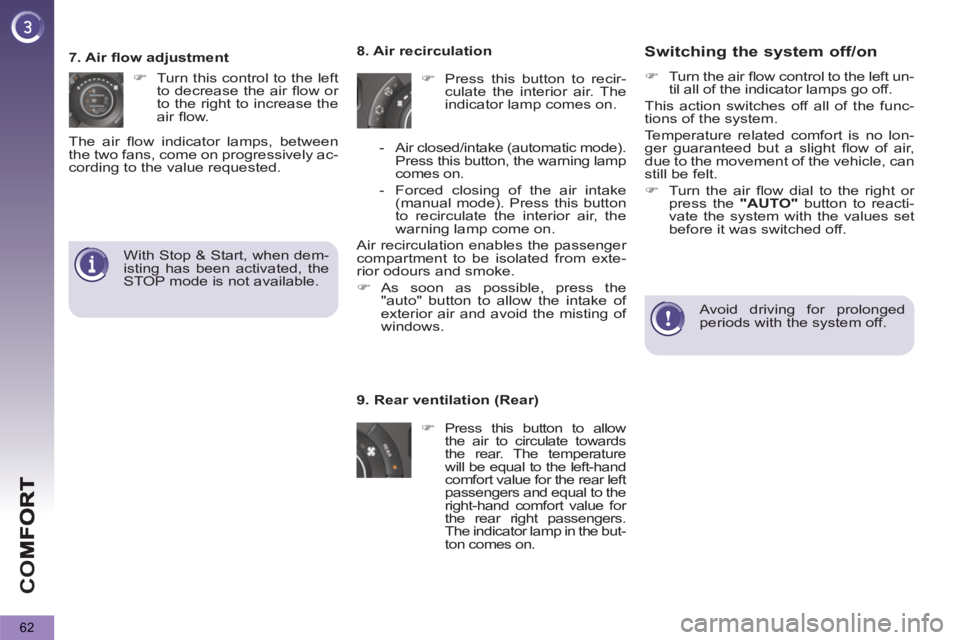
CO
62
Switching the system off/on
�)
Turn the air fl ow control to the left un-
til all of the indicator lamps go off.
This action switches off all of the func-
tions of the system.
Temperature related comfort is no lon-
ger guaranteed but a slight fl ow of air,
due to the movement of the vehicle, can
still be felt.
�)
Turn the air fl ow dial to the right or
press the "AUTO"
button to reacti-
vate the system with the values set
before it was switched off.
Avoid driving for prolonged
periods with the system off.
9. Rear ventilation (Rear)
�)
Press this button to allow
the air to circulate towards
the rear. The temperature
will be equal to the left-hand
comfort value for the rear left
passengers and equal to the
right-hand comfort value for
the rear right passengers.
The indicator lamp in the but-
ton comes on.
8. Air recirculation
�)
Press this button to recir-
culate the interior air. The
indicator lamp comes on.
- Air closed/intake (automatic mode).
Press this button, the warning lamp
comes on.
- Forced closing of the air intake
(manual mode). Press this button
to recirculate the interior air, the
warning lamp come on.
Air recirculation enables the passenger
compartment to be isolated from exte-
rior odours and smoke.
�)
As soon as possible, press the
"auto" button to allow the intake of
exterior air and avoid the misting of
windows.
7. Air fl ow adjustment
�)
Turn this control to the left
to decrease the air fl ow or
to the right to increase the
air fl ow.
The air fl ow indicator lamps, between
the two fans, come on progressively ac-
cording to the value requested.
With Stop & Start, when dem-
isting has been activated, the
STOP mode is not available.